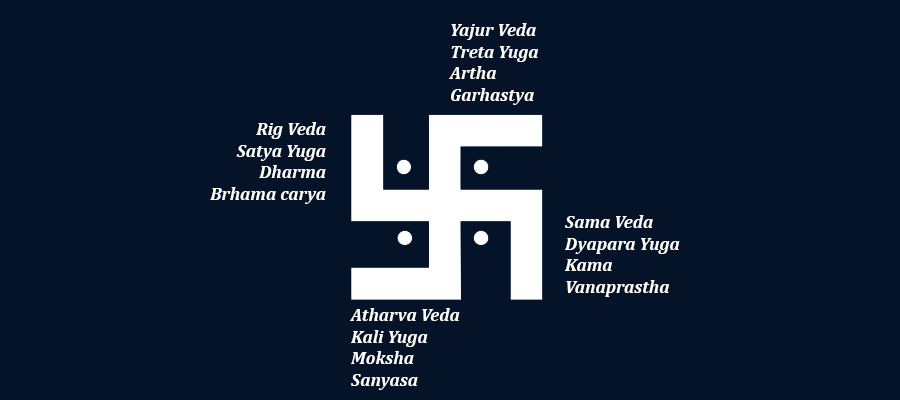Meaning and uses of Swastika
Most people who are not fully aware of the Swastika symbol used by different cultures and traditions. The word “swastika” comes from the Sanskrit word Svastika. The true meaning is given as Svastika word is formed through joining and the transformation of “su asti ka”.
- Su – means good,
- asti – means “to be”,
- ik – means “what is in existence, and will continue to exist “
- a – denotes feminine gender
So, Swastika simply means ‘let good-prevail’ and not to be destroyed and remains in good condition. Its deeper meaning is a permanent victory. In the context of the cultural origins of the swastika, this means the victory of dharma – the fundamentally spiritual nature of humanity. The word Swastika also denotes blessings for everyone.
The swastika is an equilateral cross with arms bent at right angles, all in the same direction, usually the right, or clockwise. The swastika is a symbol of prosperity and good fortune and is widely dispersed in both the ancient and modern world. The swastika has undergone some changes in different regions and religious traditions.
The most common is the traditional Hindu Swastika with straight standing character, slightly angled individual arms and four dots inside the four squarish designs. It originally represented the revolving sun, fire, or life. The swastika is used in both directions, but in Indian culture, the clockwise swastika symbolizes fortune, good health, life, and progress.
Meaning and uses of Swastika
The Swastika is a sacred symbol in Hindu tradition. It is the symbol of auspiciousness, prosperity and good fortune. Hindus use the swastika to mark the opening pages of account books, thresholds, doors, and offerings. Among the Jains, it is the emblem of their seventh Tirthankara. In the Buddhist tradition, the swastika symbolizes the feet or footprints of the Buddha and is often used to mark at the beginning of texts. Modern Tibetan Buddhism uses it as a clothing decoration. With the spread of Buddhism, it has passed into the iconography of China and Japan where it has been used to denote plurality, eternity, abundance, prosperity and long life. It is sometimes used in Japan to symbolize the Buddha’s mind.
For Hindus, the four limbs of the swastika denote :
- Four Vedas – Rig Veda, Sama Veda, Yajur Veda and Atharva Veda – Symbolizing auspiciousness
- Four Goals of Life – Dharma (righteous duty, virtue), Artha (material success, money, house etc.), Kama (pleasure, family, art, sex etc.) and Moksha (liberation, freedom etc.) – denoting prosperity in each area
- Four Stages of life – Brahmacharya(Student), Grihastha (Householder), Vanaprastha (Retired person) and Sanyasa (Ascetic) – signifying good fortune for each stage
- Four Yugas (era) – Satya Yuga (Golden Age), Treta Yuga (Silver Age), Dvapara Yuga (Bronze Age) and Kali Yuga (Iron Age) – symbolizing the natural evolution of the universe
- Four Varnas (social classes) – Brahmans (Priests, Teachers, and Intellectuals), Kshatriyas (Warriors, Police, and Administrators), Vaishyas (Farmers, Merchants, and Business People) and Shudras (Artisans and Workers) – symbolizing the progress and synergy among social classes
- Four paths of Yoga – Jnana Yoga, Bhakti Yoga, Karma Yoga and Raja Yoga – symbolizing union with the divine
- Four Directions – North, South, East and West – symbolizing the Divine omnipresence
- Four Seasons – Spring, Summer, Autumn and Winter – symbolizing the cyclic nature of time
Most of the words, when translated in other languages from Sanskrit, lose their meaning because this language is only intended for two-dimensional space. One of the keys in the Vedas and Dhyana is the ability to explain and go to the fourth level or Chaturiya (Fourth) avastha (state). The fourth country is also known as Turiya avastha. The fourth situation goes beyond waking, sleeping and dreaming.
The Swastika symbol is a four-dimensional cube symbol and is widely used in Vedic mathematics.
A small step to understanding the key to the truth in mastering arithmetic is to first master the numbers. Likewise, the key to mastering English is the alphabet. Likewise, to even begin to understand the wisdom of the Vedas, one needs to first understand and perhaps master, Yoga and Pranayama and then the language in which the instructions are conveyed.
In ancient times, when the children were first initiated by Master were from Pranayama. After gaining complete knowledge about one’s breath, the Master will begin to initiate students about Dhyana (Meditation). The steps in Dhyana will then gradually lead to understanding human sensations through feelings. The sensation roughly translates to Sama-vedana from where the word Vedana originates. Knowledge of the self, the universal self and so on, begins with the breath. Breathe, be happy and realize Swastika!
This Spirituality and Transformative Leadership Series was created in response to the need to bring the principles of ‘high order’ into current leadership and to spark ongoing discussion about the role that spirituality has, as distinct from religion, in today’s world. This is a curated series that invites Young Global Leaders and others with an interest in leadership to contribute to the discussion of the role played by spirituality in leadership today.





